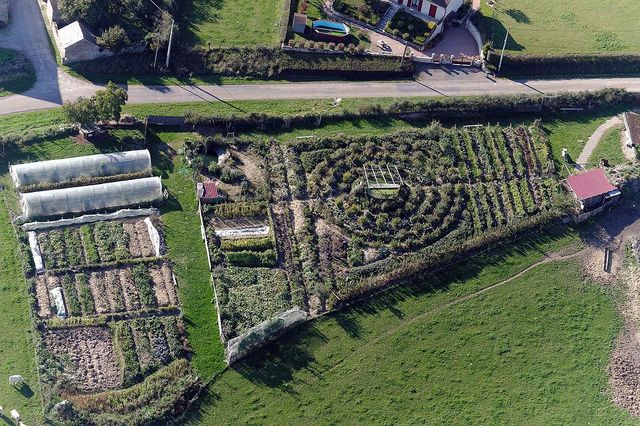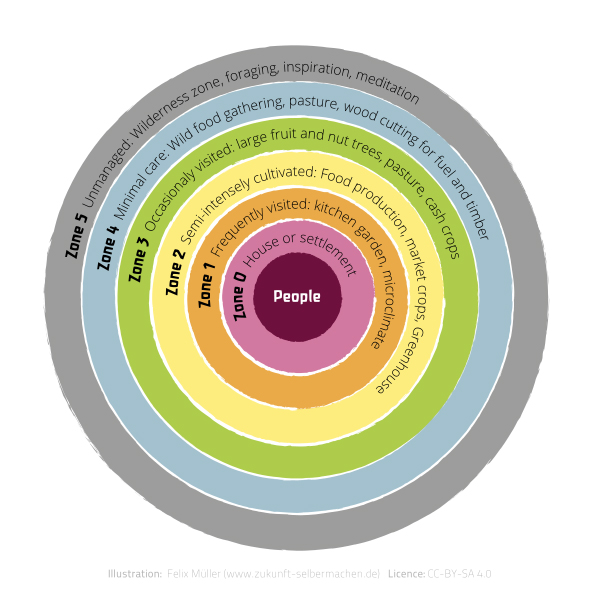Permaculture

The term related to either "Permanent Agriculture" or "Permanent Culture". Permaculture is a systems thinking design model focusing on sustainable and regenerative systems. It considers ecological theory informed by the lifestyles of indigenous cultures as well as modern technological advancements. Permaculture ranges a diverse field of design methods, anything from perennial-based agricultural systems, to the homestead, to individual or community structures.
The majority of permaculture design is considered within the framework of 'zones'. David Holmgren [2] has also theorized a series of 'meta-zones' in which he describes spheres of influence. In this meta-zone system, Zone 0 represents a person's core, their self, whereby energy inputted for change has a high likelihood of impact or result. This series of meta-zones ends at the global level; at the global level one is less likely to experience any form of direct impact.
Permaculture is considered a unique design system because of its core values and principles. While it was once considered a fringe movement of alternative culture, permaculture is now seen as an intelligent, informed, and truly important body of study:
"What permaculturists are doing is the most important activity that any group is doing on the planet. We don't know what details of a truly sustainable future are going to be like, but we need options, we need people experimenting in all kinds of ways and permaculturists are one of the critical gangs that are doing that."
Wikipedia: permaculture References et al
There is a growing movement dealing with Open Source Permaculture, in which all the agricultural information and genetic resources are shared.
Zoning
Permaculture Zones (from Wikipedia) are a way of organizing design elements in a human environment on the basis of the frequency of human use and plant or animal needs. Frequently manipulated or harvested elements of the design are located close to the house in zones 1 and 2. Less frequently used or manipulated elements, and elements that benefit from isolation (such as wild species) are farther away. Zones are about positioning things appropriately. Zones are numbered from 0 to 5:[citation needed]
- Zone 0
- The house, or home center. Here permaculture principles would be applied in terms of aiming to reduce energy and water needs, harnessing natural resources such as sunlight, and generally creating a harmonious, sustainable environment in which to live and work. Zone 0 is an informal designation, which is not specifically defined in Mollison's book.
- Zone 1
- The zone nearest to the house, the location for those elements in the system that require frequent attention, or that need to be visited often, such as salad crops, herb plants, soft fruit like strawberries or raspberries, greenhouse and cold frames, propagation area, worm compost bin for kitchen waste, etc. Raised beds are often used in zone 1 in urban areas.
- Zone 2
- This area is used for siting perennial plants that require less frequent maintenance, such as occasional weed control or pruning, including currant bushes and orchards. This would also be a good place for beehives, larger scale composting bins, and so on.
- Zone 3
- The area where maincrops are grown, both for domestic use and for trade purposes. After establishment, care and maintenance required are fairly minimal (provided mulches and similar things are used), such as watering or weed control maybe once a week.
- Zone 4
- A semi-wild area. This zone is mainly used for forage and collecting wild food as well as timber production.
- Zone 5
- A wild area. There is no human intervention in zone 5 apart from the observation of natural ecosystems and cycles.
See Also
Online Resources
- Permaculture: A Designer's Manual by Bill Mollison. The book that started it all, available on The Pirate Bay.
- Bill Mollision Lecture Series Www.networkearth.org providing Bill Mollison's permaculture lecture series on video for free download
- An Introduction to Permaculture - a torrent with 12 gigabytes of educational books and videos about permaculture, agroforestry and things like that. Includes The One Straw Revolution by Masanobu Fukuoka.
- Permaculture Wiki
- WikiEducator: permaculture design
- WikiEducator: category:permaculture
- Plants for a Future Database >7k species, lots edible perennials
- NewCrop Perdue's edible species profiles
- AgroForestryTree Database World Agroforestry Center's tree species profiles
- Forest, Farm, and Community Tree Network more agroforestry resources
- Food and Nutrition Library 2.2 lots of free e-books on food, nutrition, farming
- Permaculture Research Institute certificate course summary pdf
